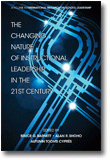
The Changing Nature of Instructional Leadership in the 21st Century
Edited by:
Alan R. Shoho, University of Texas at San Antonio
Bruce G. Barnett, University of Texas at San Antonio
Autumn K. Tooms, Kent State University
A volume in the series: International Research on School Leadership. Editor(s): David Gurr, University of Melbourne, Australia. Elizabeth T. Murakami, University of North Texas.
Published 2012
This third book in the Information Age book series, International Research on School Leadership, focuses on the changing nature of instructional leadership in the 21st century. Our goal is to examine instructional leadership from multiple educational and international perspectives. Unlike many leadership books that focus on conceptualizations and personal narratives, the seven chapters provide empirical evidence of how instructional leadership is evolving in the 21st century. From the effective schools research of the 1980s to today’s relentless calls for improved student performance, attention has focused on the instructional leadership roles and responsibilities of school principals, headteachers, and educational system leaders. The emphasis on student performance has gone global as evidenced by highly-publicized international studies, such as the Trends in International Math and Science Studies (TIMSS) and the Program for International Student Assessment (PISA), comparing student achievement in different countries.
These developments have had substantial effects on school leaders, especially building-level principals and headteachers. Rather than being the only ones overseeing school improvement aimed at increasing student learning, many school administrators are distributing leadership responsibilities to other administrators and teachers on their campuses. To fully understand instructional leadership in the 21st century, the book examines three important dimensions of instructional leadership: (1) the current context for turning around low-performing schools, increasing teacher effectiveness, and providing equitable outcomes for all students, (2) international perspectives of instructional leadership development, particularly the value of teacher coaching and leadership development for aspiring and practicing school leaders in a developing country, and (3) the obstacles instructional leaders confront as they deal with fiscal constraints, political pressure, diverse student populations, and high-stakes standards-based reforms.
CONTENTS
Acknowledgments. Introduction, Bruce G. Barnett, Alan R. Shoho, and Autumn Tooms Cyprès. SECTION I: THE CONTEXT FOR INSTRUCTIONAL LEADERSHIP AND SCHOOL IMPROVEMENT. The Judgment of Principals: A Key to Understanding Tough Calls and Instructional Leadership, Daniel L. Duke. Instructional Practice, Teacher Effectiveness, and Growth in Student Learning in Math: Implications for School Leadership, Ronald H. Heck. Leadership for Equity: Distributed Leadership in Linked Learning Schools, Erica Hamilton and Jennifer Crawford. SECTION II: INTERNATIONAL PERSPECTIVES OF INSTRUCTIONAL LEADERSHIP DEVELOPMENT. The Numeracy Coaching Program: An Examination of the Program Impact from the Training Room into School Classrooms, Gary R. O’Mahony. Responding to a Changing World: Challenges and Early Findings in Orchestrating a Principal Professional Development Program in Indonesian Schools, Khairan Indriani, Luana Zellner, and Steven Rose. SECTION III: OBSTACLES AND CONSTRAINTS CONFRONTING INSTRUCTIONAL LEADERS. Leading with Less: Principal Leadership in Austere Times, Chad R. Lochmiller. School-Based Instructional Leadership in Demanding Environments: New Challenges, New Practices, Michael S. Knapp, Simangele T. Mkhwanazi, and Bradley S. Portin. About the Contributors.
-
Paperback978-1-61735-938-5
Web price: $45.04 (Reg. 52.99)
-
Hardcover978-1-61735-939-2
Web price: $80.74 (Reg. 94.99)
- eBook978-1-61735-940-8

- EDU037000 - EDUCATION: Research
- EDU032000 - EDUCATION: Leadership
- EDU001000 - EDUCATION: ADMINISTRATION: General
-
 Challenges and Opportunities of Educational Leadership Research and Practice
The State of the Field and Its Multiple Futures
Challenges and Opportunities of Educational Leadership Research and Practice
The State of the Field and Its Multiple Futures
-
 Educational Leadership for Social Justice and Improving High-Needs Schools
Findings from 10 Years of International Collaboration
Educational Leadership for Social Justice and Improving High-Needs Schools
Findings from 10 Years of International Collaboration
-
 Educational Leadership, Culture, and Success in High-Need Schools
Educational Leadership, Culture, and Success in High-Need Schools
-
 Examining the Assistant Principalship
New Puzzles and Perennial Challenges for the 21st Century
Examining the Assistant Principalship
New Puzzles and Perennial Challenges for the 21st Century
-
 School and District Leadership in an Era of Accountability
School and District Leadership in an Era of Accountability
-
 School Principals in Mexico
Cases of Leadership Success
School Principals in Mexico
Cases of Leadership Success
-
 Using Data in Schools to Inform Leadership and Decision Making
Using Data in Schools to Inform Leadership and Decision Making

